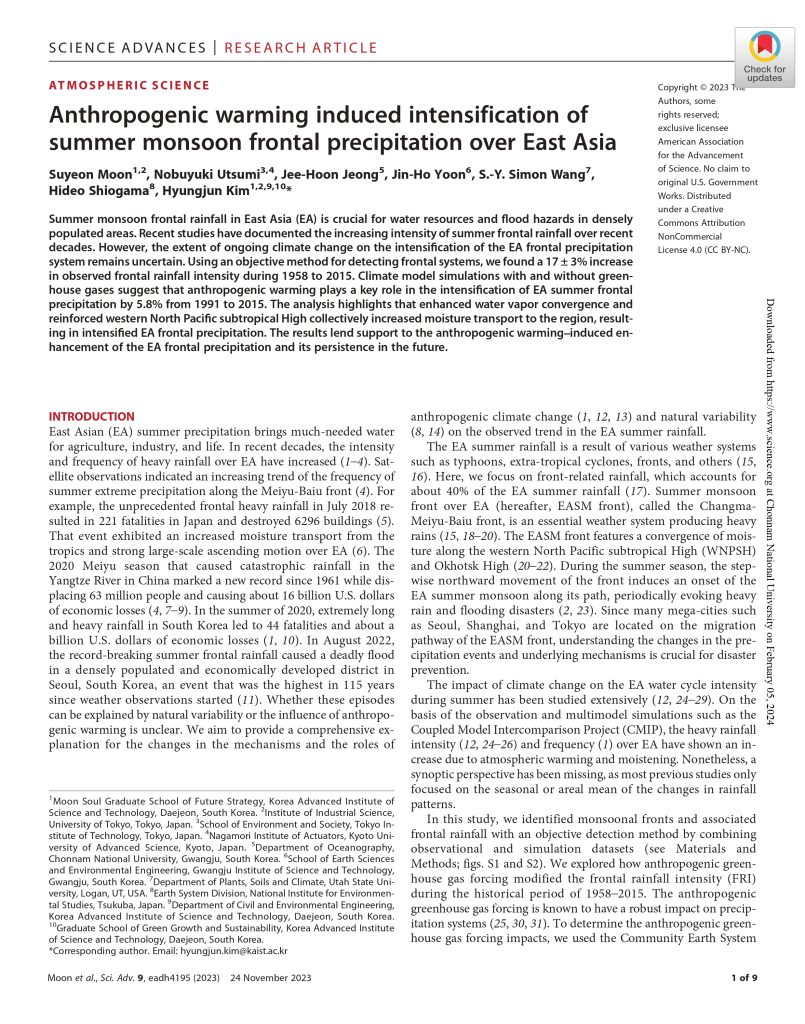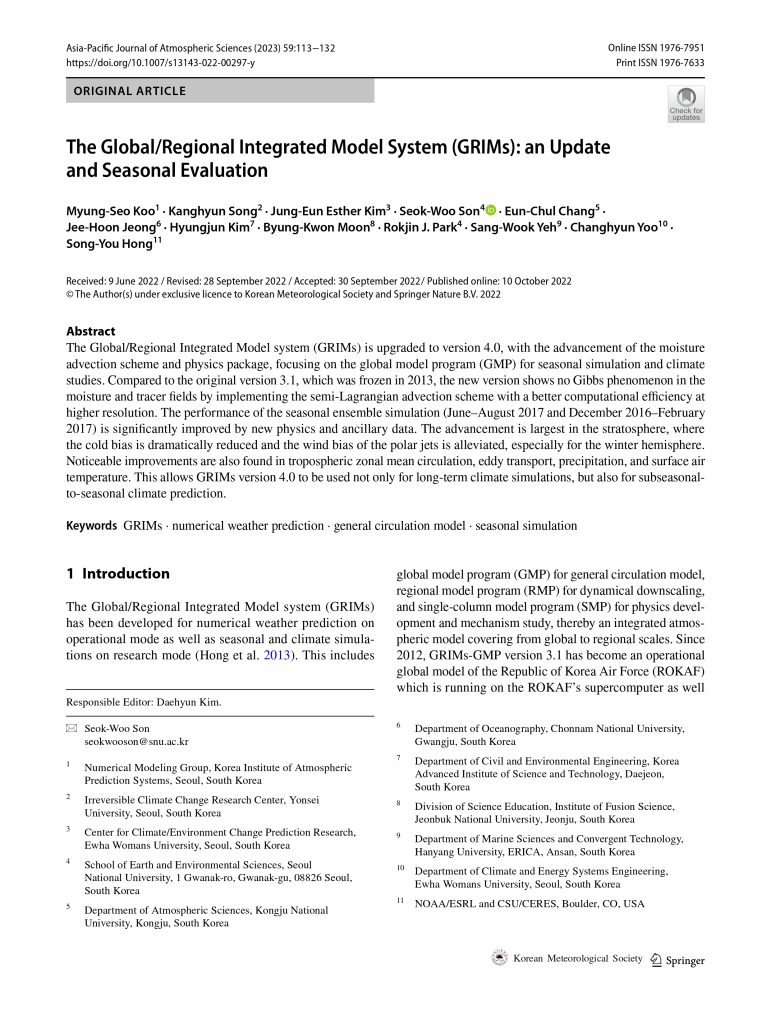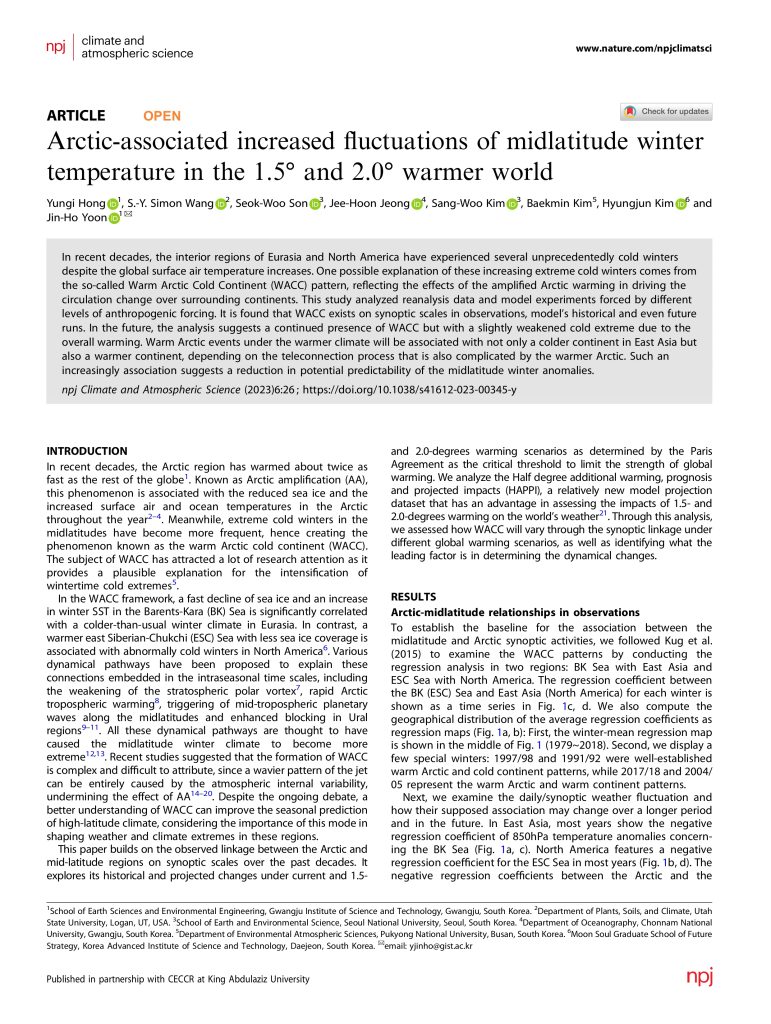70. Anthropogenic warming induced intensification of summer monsoon frontal precipitation over East Asia

Suyeon Moon, Nobuyuki Utsumi, Jee-Hoon Jeong, Jin-Ho Yoon, S.-Y. Simon Wang, Hideo Shiogama, Hyungjun Kim
Summer monsoon frontal rainfall in East Asia (EA) is crucial for water resources and flood hazards in densely populated areas. Recent studies have documented the increasing intensity of summer frontal rainfall over recent decades. However, the extent of ongoing climate change on the intensification of the EA frontal precipitation system remains uncertain. Using an objective method for detecting frontal systems, we found a 17 ± 3% increase in observed frontal rainfall intensity during 1958 to 2015. Climate model simulations with and without greenhouse gases suggest that anthropogenic warming plays a key role in the intensification of EA summer frontal precipitation by 5.8% from 1991 to 2015. The analysis highlights that enhanced water vapor convergence and reinforced western North Pacific subtropical High collectively increased moisture transport to the region, resulting in intensified EA frontal precipitation. The results lend support to the anthropogenic warming–induced enhancement of the EA frontal precipitation and its persistence in the future.
69. The Global/Regional Integrated Model System (GRIMs): an Update and Seasonal Evaluation

Myung-Seo Koo, Kanghyun Song, Jung-Eun Esther Kim, Seok-Woo Son, Eun-Chul Chang, Jee-Hoon Jeong, Hyungjun Kim, Byung-Kwon Moon, Rokjin J. Park, Sang-Wook Yeh, Changhyun Yoo & Song-You Hong
The Global/Regional Integrated Model system (GRIMs) is upgraded to version 4.0, with the advancement of the moisture advection scheme and physics package, focusing on the global model program (GMP) for seasonal simulation and climate studies. Compared to the original version 3.1, which was frozen in 2013, the new version shows no Gibbs phenomenon in the moisture and tracer fields by implementing the semi-Lagrangian advection scheme with a better computational efficiency at higher resolution. The performance of the seasonal ensemble simulation (June–August 2017 and December 2016–February 2017) is significantly improved by new physics and ancillary data. The advancement is largest in the stratosphere, where the cold bias is dramatically reduced and the wind bias of the polar jets is alleviated, especially for the winter hemisphere. Noticeable improvements are also found in tropospheric zonal mean circulation, eddy transport, precipitation, and surface air temperature. This allows GRIMs version 4.0 to be used not only for long-term climate simulations, but also for subseasonal-to-seasonal climate prediction.
68. Arctic-associated increased fluctuations of midlatitude winter temperature in the 1.5° and 2.0° warmer world

Yungi Hong, S.-Y. Simon Wang, Seok-Woo Son, Jee-Hoon Jeong, Sang-Woo Kim, Baekmin Kim, Hyungjun Kim & Jin-Ho Yoon
In recent decades, the interior regions of Eurasia and North America have experienced several unprecedentedly cold winters despite the global surface air temperature increases. One possible explanation of these increasing extreme cold winters comes from the so-called Warm Arctic Cold Continent (WACC) pattern, reflecting the effects of the amplified Arctic warming in driving the circulation change over surrounding continents. This study analyzed reanalysis data and model experiments forced by different levels of anthropogenic forcing. It is found that WACC exists on synoptic scales in observations, model’s historical and even future runs. In the future, the analysis suggests a continued presence of WACC but with a slightly weakened cold extreme due to the overall warming. Warm Arctic events under the warmer climate will be associated with not only a colder continent in East Asia but also a warmer continent, depending on the teleconnection process that is also complicated by the warmer Arctic. Such an increasingly association suggests a reduction in potential predictability of the midlatitude winter anomalies.